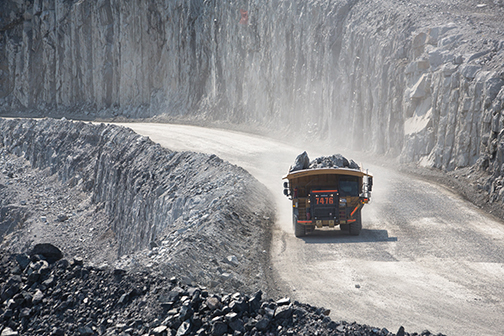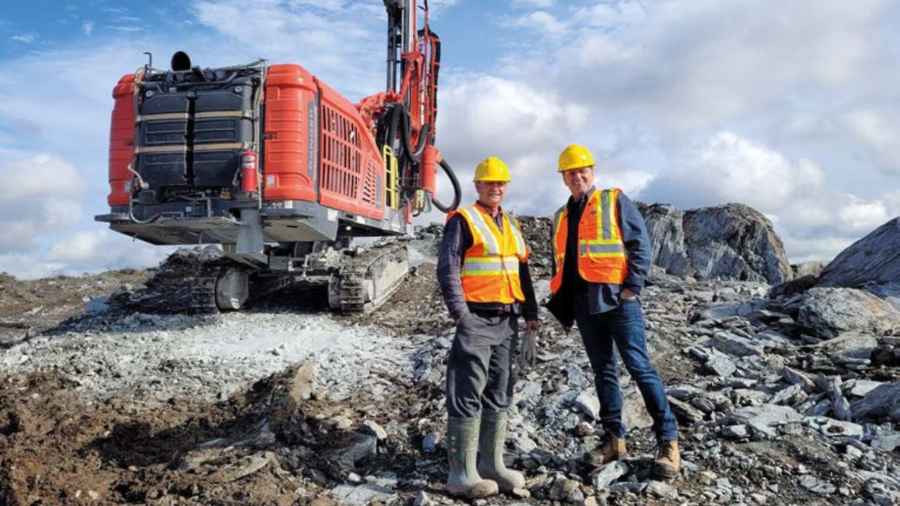Road to Riches
For the past two decades, the Ontario Mining Association has published several reports on the contribution of the mining industry to the provincial economy and in keeping with this practice, the OMA is once again proud to have been instrumental in the preparation of an in-depth report that extends and expands upon its past studies.
Canadian Mining Journal is equally proud to present some of the highlights of that Report, entitled: “Mining: Dynamic and Dependable for Ontario’s Future,” an 80-page document by Peter Dungan* and Steve Murphy* that examines many different aspects of the Ontario mining industry, including its importance to the provincial economy now and in the future, and the industry’s efforts to make this contribution in an increasingly safe and sustainable way.
As mentioned, the Report is an extensive document based on a wide variety of published data, a survey of OMA members, and input-output calculations conducted by the authors. By the nature of such a detailed report, it contains far more information (including numerous charts and graphs) that it cannot be published in its entirety but again, CMJ is pleased to provide some of the highlights of the Report in our “Mining in Ontario” issue.
Without question, mining in Ontario is very diverse, covering a wide range of mineral commodities, including gold (this month’s Cover Story), nickel, copper, salt (also a feature article this month), diamonds and a number of structural building materials.
There are more than 35 active mining operations in Ontario. Output from metal mines continues to account for the majority of the value of production in the province. Over the last 10 years, the value of total mineral production in the province climbed to a peak of almost $10.9 billion in 2007, before falling to its lowest level since 2003 in 2009, due to the effects of world economic weakness, exacerbated by a sustained labour dispute in Sudbury.
By 2011, with non-metal mining at new highs and metal mining output climbing strongly, the total value of mineral production hit $10.7 billion.
The contributions of the different types of mineral commodities to the total value of mineral production in the province have changed considerably over the last 10 years. With the impacts of the opening of new mines, expanding or closing of existing ones, commodity price swings, as well as labour disputes in certain years, the importance of individual commodities has changed dramatically.
While the shares of the value of production of both gold and nickel in 2011 at over 20% are roughly where they were in 2002, their contribution in the intervening years has swung wildly. In 2007, the value of nickel production accounted for 42% of all mineral production in Ontario.
By 2009, however, this share had fallen to only 11% as the share of gold production soared to almost 30%. Over the 10 year period, the share of the value of copper production climbed almost 10 percentage points. Over the last 10 years, the share of value of metal mines production climbed from 62% in 2002 to more than 70% in 2011, with its greatest share coming in 2007 at more than 76%.
With the start of the province’s first diamond mine in 2008, the value of diamond production has climbed to over 4% of total mineral production, closing in on the level of the value of salt production.
Overall, the share of non-metal mines production has climbed over the last 10 years, sitting at over 11% in 2011. The value of the production of structural materials such as clay, cement, lime, stone, sand and gravel has been quite steady over the last 10 years. Therefore, as the value of the output of many metal minerals has swung up and down, the share of structural materials has moved in the opposite direction. Over the last 10 years, the share of all of the structural materials components have fallen, such that by 2011 the total share of the value of this production was down to just over 18% from over 30% in 2002.
Ontario, at $7.5 billion, is the largest producer of metal mineral commodities in the country in 2011, accounting for 30% of the country’s production, well ahead of Quebec at 24%. Ontario mining companies produced the most gold (52%), nickel (43%), copper (38%), platinum group metals (84%) and silver (28%) in the country, as well as the second most cobalt (36%).
Ontario is also the biggest producer of salt in the country, and second in the country (behind the Northwest Territories) in diamond production. Overall, Ontario non-metal mines produced $1.2 billion of output in 2011 or almost 10% of national output, placing it behind only Saskatchewan (potash) and the Northwest Territories (diamonds) in its output ranking in the country.
Once again, Ontario is also the most important producer of structural materials in the country. The province mines the most stone (41%), lime & clay (53%), sand & gravel (31%), and produces the most cement (35%) of any province. At $1.9 billion, the value of structural materials production in Ontario accounted for 37% of the Canadian total.
Ontario mined $10.7 billion, or almost 25% of all Canadian non-fuel mineral production in 2011, accounting for more than 1.6% of the total value of GDP in Ontario.
Mining Industry
Employment and Wages
As the world economy slowly recovered from the recent “great recession,” employment in the mining sector began to rebound in 2011. The number of workers directly employed by Ontario’s mining industry, at over 19,400, climbed to a 15-year high in 2008. By 2010, employment in the industry had fallen by over 25%, as the impacts of the recession and labour issues continued to be felt, before recovering to more than 16,000 in 2011.
Metal mining remains the most important mining sector in Ontario with over 63% of all mining employees involved in metal ore mining in the province in 2011, although this is a much lower share than seen in the 1990s. Support activities to mining (which includes contract drilling, exploration, and other mine services) have become increasingly important in the province over the last several years.
In 2011, for example, almost 8,000 workers were employed in this sector, the highest level ever recorded for the province by Statistics Canada and more than double the number employed a decade ago. Other than the recent peak in 2008, overall, employment in 2011 in the Ontario mining industry directly, together with services to the mining industry, is at its highest level in 20 years.
Ontario accounts for a large share of Canada’s mining employment, particularly in metal ore mining. Of the total number of people employed in metals mining in Canada in 2011, Ontario accounted for almost 38%, somewhat below the average share seen over the last 10 years.
For all types of mineral production, Ontario accounts for over 28% of the country’s employment, somewhat higher than 2010 but still at a level below that seen in recent years.
The recovery in employment is not reducing the output per worker in the industry. The value of output per worker employed at metal mines in the province hit a peak of almost $900,000 in 2007 before dropping in the downturn. This measure has recovered in 2011 to almost $740,000. Output per worker in all mining in 2011 is a still impressive $680,000, roughly six times the provincial industrial average.
Using data collected from Ontario Mining Association members, one can look at the numbers of different types of jobs in the mining industry, as well as in what parts of the province this employment takes place and the nature of the mining labour force.
In 2011, more than 83% of employment took place at the mine site, with 71% of total mining employment devoted to mine-site production and engineering activities and a further 12% providing administration support at the mine. According to the survey results, just under two per cent of mining employees were involved in scientific/R&D activities, more than seven per cent were involved in exploration, and eight per cent were employed at mining head offices.
Employment was spread all over the province. In 2011, results from the OMA survey indicate that roughly 36% of mining employment in the province took place in Sudbury, down from over 37% in 2010, and from the 50% share reported in a previous OMA survey for the average of years 2006 and 2007.
Employment in Northeastern Ontario accounted for over 30% of the total in 2011, up from 28% in 2010, and 23% in 2006/2007. This reflects the opening of Ontario’s only diamond mine in 2008, as well as renewed interest in developing new, or reopening old gold mines as the price of the commodity has climbed. The share of employment in Northwestern Ontario stood at 19.2% in 2011, down slightly from the 19.6% seen in 2010, but up from the 15% level of 2006/2007.
Finally, the share of employment in the southern part of the province, which is home to salt, gypsum, talc, nepheline syenite and calcium carbonate mines, as well as mining head offices in Toronto, fell somewhat to 14.5% in 2011 from 15.3% in 2010, similar to the 14% seen in 2006/2007.
A number of interesting features of the nature of employment in the mining industry show that for the years 2004, 2007, 2010 and 2011, the percentage share of employees over 55 years of age has remained fairly stable, ranging only from 14% in 2004 and 2010, to 17% in 2007 and 15% in 2011.
The shares of the other two age profiles have changed quite dramatically, however, over this period. Employees aged 35 and younger accounted for only 18% of employment in 2004 but reached 27% in 2011. Conversely, those aged 36-55 in 2004 accounted for 68% of employment, dropping to 58% in 2011.
Ensuring that Aboriginals participate in the mining industry has become an increasing focus in recent years. As new mineral resources are discovered in farther north and remote environments, agreements have been undertaken to make sure that, wherever possible, Aboriginal employment is encouraged.
According to Natural Resource Canada and the Mining Association of Canada, based on Census figures, Aboriginal employment in Canada accounted for 7.5% of total Canadian mining employment in 2006, up from 5.1% in 2001 and 3.6% in 1996. Data from the new OMA survey suggest that Aboriginal employment accounted for 9.7% of mining employment in Ontario in 2011, up from 9.5% in 2010. These increases reflect the impact of mines like the DeBeers Victor operation which opened in 2008 with a 40% Aboriginal employment share. With recent agreements signed with a number of mining companies, this figure is expected to increase in the future.
Two other interesting features of mining employment in the province have emerged. Responses to a recent OMA survey suggest that the share of employment in the Ontario mining industry of females rose to 11.1% in 2011 from 10.5% in 2010. Also, it is apparent that mining operations in Ontario are becoming increasingly non-unionized. In 2011, 35.5% of employees in the Ontario mining industry were unionized, down from 37.6% in 2010.
Comparing Employment
While employment in Ontario’s mining and supporting industries has increased over the last 10 years, the same cannot be said about the broader mineral-based industries. Employment in industries downstream from the mining industry itself, the industries that use the mined materials, has dropped quite dramatically over the period.
With the strength of the Canadian dollar impacting these industries’ competitiveness, as well as the rise in a number of low-cost manufacturing countries, Ontario’s primary metals and fabricated metal products industry employment has fallen by more than one-third over the last 10 years. Employment in non-metallic minerals manufacturing has fallen about 10%, compared to the 42% increase in mining and support activity employment.
Employment in mining has also been solid when compared to other resource-based industries in Ontario. The productivity of workers in the Ontario mining sector is also impressive. Workers in all industries in Ontario are roughly 62% as productive as those in the mining industry, with workers in goods producing industries 85% as productive, and workers in service industries 58% as productive. Workers in the manufacturing sector in Ontario produce 82% as much real output as a mining industry worker. In other resource-based industries, forestry and logging workers are 89% as productive, while wood product manufacturing workers are 70% as productive.
In other industries that rely on the mining industry, primary and fabricated metal manufacturing, workers were 71% as productive in 2011 as workers employed in mining, while non-metallic manufacturing workers are 82% as productive. Clearly, workers in the mining sector are not only producing a high value product, but as employment has increased, are remaining very productive relative to other Ontario industries.
Not only is employment growing in the mining sector in Ontario but the jobs are very well paying. The average weekly wage paid in the mining industry was almost 60% more than the Ontario’s average industrial wage, while wages paid in the mining support sector were almost 95% higher.
Wages in the mining resource sector exceed those in other resource based industries in the province. As well, wages in the mining sector exceed those in a number of other industries that are considered vital to the Ontario economy, including manufacturing of transportation equipment and construction. The wages paid in the Ontario mining industry and its mining support sector also far outstrip those in industries that utilize mining output.
Distribution of Employment
In 2011, almost 65% of total wages and salaries paid in the industry went to workers in mine-site engineering and production, up from 61.5% in 2010 (which was impacted by a nearly 12-month strike in Sudbury that lasted until the middle of that year).
Mine-site administration workers accounted for almost 14% of wages and salaries paid in 2011, down from 16.2% in 2010. The share of head office wages and salaries is the next highest hitting almost 11% in 2011 (down from 12.7% in 2010), followed by wages and salaries in exploration, at 7.8% in 2011 (up from 7.1% in 2010) and finally employees involved in R&D accounting for under 3% of wages and salaries (roughly the same as 2010).
The total wage bill for the industry in the province is estimated to be over $1.7 billion in 2011, up sharply from $1.4 billion in 2010.
Sudbury accounts for more than 37% of the industry’s wage bill in 2011, greater than its 35.8% share of employment. This wage share is greater than that seen in 2010 (33.4%, which, noted earlier was impacted by a major strike) but far below the share of 60% for 2006/2007 reported in an earlier OMA survey.
The Northeast’s share of wage compensation, (at 28.6%) is somewhat lower than its employment share in the province (30.5%) but higher than the wage share of 2010 (27.7%) even with the recovery in Sudbury, and dramatically higher than the wage share seen in 2006/2007 (16%).
Workers in the Northwest part of the province accounted for 17.3% of wages and salaries in 2011, less than its 19.2% employment share, but higher tha
n the 14% wage share seen in 2006/2007.
Finally, the wage share of the southern part of the province in 2011, at 16.9%, is greater than its employment share (14.5%), but lower than its share both in 2010 (20.5%) and 2006/2007 (22%).
On top of wages and salaries paid to workers in the industry, companies also provide taxable benefits (which could include automobile benefits, meals, board and lodging, tool reimbursement or allowance among many others) and non-taxable benefits (which could include certain health plan premiums, remote worksite allowances, and private pension plan contributions).
Mine Safety
Ontario’s mining industry is moving toward its goal of “zero harm in the workplace by 2015.” Over the past 30 years, the industry’s overall safety performance has improved dramatically and it continues to move in that positive direction.
According to statistics provided by Workplace Safety North, a provincial safety and accident prevention organization, the lost-time injury rate for mining in the first nine months of 2012 was 0.4 per 200,000 hours. This has come down from rates of six per 200,000 hours in 1981, to three in 1991, to 1.3 in 2001 and to 0.6 in 2011.
Similarly, total medical injury rates have come down to 5.4 per 200,000 hours for the first nine months of 2012. The total medical injury rate for mining was 20 per 200,000 hours in the early 1980s, 17.7 in 1991, 9.5 in 2001 and six in 2011.
To maintain high standards of safety, mining companies continue to emphasize training. As technology and equipment become more sophisticated, fewer people operate equipment and more people design, develop and maintain equipment. According to the results from the latest OMA industry survey, an average of $711 per employee was spent on training in 2011, up from $651 in 2010. A further $1,072 per employee was spent on health and safety initiatives in 2011, compared to $1,056 in 2010.
Commodity Prices
Clearly, a crucial factor in the value of mineral production and the interest in exploring for new sources of possible mineral production in the province is the value that is placed upon this production. International markets dictate prices for mineral commodities.
Gold and silver prices have strengthened considerably over the last 10 years, while base metal and platinum group metal prices have fluctuated dramatically. Because commodities are priced in U.S. dollars, monetary exchange rates have historically had a significant impact on the Canadian dollar revenues generated by Ontario mining companies, which was particularly noticeable during the 2008-09 economic downturn when the exchange rate plummeted.Recently, however, with the Canadian dollar vis-a-vis its U.S. counterpart roughly at par, the impact is less obvious.
Since the beginning of 2006, the prices of gold and silver in $C have increased by a factor of roughly three. Through the first nine months of 2012, the $C price of gold averaged more than $1,650 per ounce, over $100 an ounce more than the 2011 average, and $400 an ounce greater than the 2010 annual average.
Nickel and zinc prices, meanwhile, soared throughout 2006 and early 2007 before slumping over the next two years, then recovering somewhat in the subsequent period. After averaging $10.25 a pound in 2010, the $C price of nickel in the first nine months of 2012 has averaged just over $8 a pound, the same as that seen in 2004 and 2005.
The price of copper has increased dramatically over the last 10 years, but there have been a number of peaks and valleys along the way. After a period of relative price stability in 2002 and most of 2003, the value of copper quadrupled by the beginning of 2006 to $C4 per pound. The price bounced between $C3 and $C4 per pound over the next two years before falling to $C1.75 by the end of 2008 as the world economic crisis took hold. Since then, the price for copper peaked at roughly $C4.50 per pound in early 2011, averaging $C3.95 for calendar year 2011 and $3.62 through the first nine months of 2012.
Taxes Paid
Employers in the Ontario mining industry paid $170 million in payroll taxes in 2011, up from nearly $140 million in 2010. The provincial government was the recipient of the bulk of these taxes, with revenues from the Employer Health Tax and WSIB premiums totaling over $111 million in 2011, up from $87 million in 2010.
Corporate income tax data by industry at the provincial level are difficult to estimate, but using information from the ENTRANS Policy Research Group report, “Revenues to Governments from the Canadian Mineral Sector 2002-2011” prepared for the Mining Association of Canada, we can estimate a range of the tax take by level of government.
In 2011 in Canada, ENTRANS estimates that the mining industry paid $992 million in federal corporate income tax and $811 in total provincial corporate income tax. If we assume that Ontario accounted for 25% of this value in 2011, the federal income tax paid in the province would amount to almost $250 million, while the provincial tax take is estimated to be $203 million. If the share were 35%, the federal corporate tax take in the province is almost $350 million, with the province taking in another $284 million.
Local taxes by mining companies are particularly important to the northern regions of the province. According to responses to the OMA industry survey, almost $19 million in local property taxes were paid in the Sudbury region in 2011, down somewhat from the $20 million paid in 2010.
Clearly, this is a significant part of the local tax base in this region. Local taxes in the Northeast part of the province totaled over $6 million in 2011, up from $5.7 million the previous year. In the Northwest, property taxes totaled $4.4 million in 2011, while in the south the number stood at $2.5 million. Overall, roughly $32 million were paid in property taxes across the province, providing important support for local services. And finally, Ontario’s miners take corporate social responsibility very seriously as mining companies in the province continue to strive to be responsible partners in improving the community in which they operate.
In fact, charitable donations have approached $10 million in each of 2010 and 2011, and that’s just one more of the benefits that Ontario’s mining companies contribute to the province.





Comments